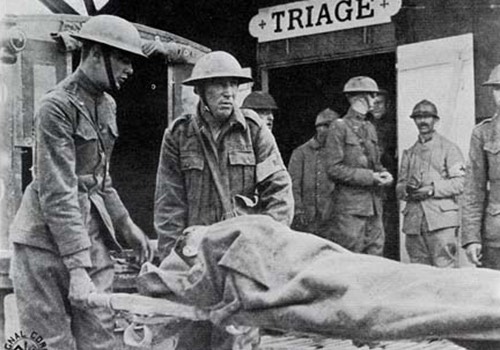
Military interests are often credited with driving scientific and technological advancements, both in war and in peace. The Great War witnessed the rise of many new weapons and ways to destroy the human body, but in other areas, people were working just as hard to devise new means of preserving human life. Medical treatment on the battlefield had been around for hundreds of years, but advances in medical science throughout the war saved countless more lives than was possible merely a decade before. During the war, cutting edge technologies were tested in the most extreme conditions imaginable, many of which proved successful enough to still exist, albeit in various iterations, to this day. One of the most innovative techniques used in the Great War was a system of assessing and treating casualties that is the backbone of modern trauma care today: triage. This derivative of a French verb for to select describes a process of categorizing injuries to determine severity and priority of care. While this system was in use before the Great War, medics and nurses during the war codified its implementation for all patients, which allowed for rapid response to and stabilization of the most critically hurt. Another area of great advances in the war was the use of antiseptics and anesthetics. Florence Nightingale pioneered the importance of cleanliness during the Crimean War, but the widespread use of chemical sanitation in field hospitals really began in the Great War. At the beginning of the war, anesthetics were only administered by highly trained surgeons or doctors, but the sheer volume of the wounded required an all hands on deck approach to patient care and soon medics and nurses were approved to provide this lifesaving treatment. The Great War also necessitated the development of many new painkilling compounds, including new forms of morphine and other opiate related drugs. Logistics of medical care in the field changed dramatically during the war. By the war’s conclusion, efficient evacuation techniques, starting with stretcher bearers on the front line and ending at fully functional field hospitals, helped keep the already astronomical death toll from rising.

Interestingly enough, not only did medicine in the Great War save lives, it also helped engineer a radical restructuring of gender interactions in the services. Nursing, as a military necessity, had been around for hundreds of years, but the magnitude of destruction wrought by modern weapons and tactics magnified the importance of these women on and near the frontline (during this time nursing was assumed to be a woman’s job). The Great War acted as a proving ground for women serving alongside men in a modern army, but even though this was revolutionary, women were not allowed to hold rank as officers. Even in a paternalistic military, nurses played many roles in the Great War. Most obviously, nurses were caregivers, but they provided an immeasurable amount of emotional and psychological support to the thousands of soldiers they treated. The importance of nursing during the Great War can be seen by the dramatic increase in women serving in these positions. In the two years that the U.S. was involved, the number of nurses enlisted in the armed services doubled. Just as women’s roles on the battlefield were affirmed by nursing in the Great War, the Red Cross also became a vital organization to medical treatment in times of war during this period. Through the Red Cross, volunteers partnered with military doctors and nurses to fill the inevitable gaps in personnel created by the enormity of the conflict. After America joined the war in 1917, membership and funding for the Red Cross reached unprecedented levels; President Wilson established a special council to raise funds specifically for them, and membership grew to over twenty million. The Great War’s heretofore unknown levels of destruction created a need for better medical treatment on the battlefield, lead to advancements in medical sciences that still are used today, and proved the resourcefulness of women and civilian volunteers in war.
By Micheal Williams
Picture Source
http://www.cnn.com/2014/07/01/opinion/davis-world-war-i-women/index.html
For Further Reading/Sources:
https://ceufast.com/blog/nursing-and-medicine-during-world-war-i
http://online.wsj.com/ww1/triage
https://wwionline.org/articles/american-red-cross/
https://rememberingwwi.villanova.edu/red-cross/